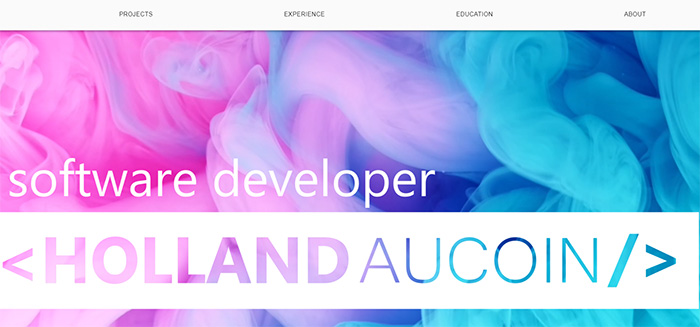
By Lana Sweeten-Shults
GCU News Bureau
Uriel Serna knew big data analytics could do big things.
So for the computer science major’s senior capstone project, a yearlong endeavor for technology students meant to showcase all that they have learned at Grand Canyon University over their four-year career, he decided to create something important.
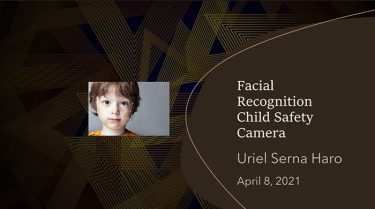
“Throughout my computer science program, I was intrigued at how big data was being used and how technology is advancing. I believed that it could be used to save lives,” said Serna, one of more than 60 computer science, computer programming and information technology/cybersecurity students who presented about 40 projects at the Spring 2021 Technology Capstone Showcase.
“The Senior Capstone Project is one of the students’ first opportunities to take on a large project, requiring them to apply time-management skills and often learning new technologies, which mirrors many of the same challenges they will face in their first job in the industry,” said Assistant Professor Mark Reha, who teaches computer programming, computer science, software engineering and IT classes.
The virtual event Thursday, a collaboration between the College of Science, Engineering and Technology and Strategic Employer Initiatives, capped off senior technology students’ academic careers at GCU and primes them for graduation, just around the corner.
It’s their exit ticket, so to speak, from the college as they launch themselves into the career world.
It also offered a chance for them to showcase their work to industry professionals – potential employers – who were invited to attend the event.
Serna’s project: a facial recognition child camera.
Living in Arizona, where backyard pools to escape the desert heat are common, Serna knew that child drowning deaths were a problem. According to the Centers for Disease Control, drowning is responsible for more deaths in children ages 1-4 than any other cause, excluding birth defects. And fatal drowning remains the second leading cause of unintentional injury-related deaths for children ages 1-14.
So he created a portable nanny camera that uses machine learning to recognize faces. When a young family member wanders into a potentially unsafe area of the home, such as the swimming pool area, his device sets off a tone to alert the user.
Serna built his facial recognition system out of a computer the size of a credit card, called a Raspberry Pi, plus a 5 megapixel ArduCAM camera, a 3.5-inch LCD screen and a power bank. He used Python software, among others.
Users launch the system’s camera to begin the process to train the computer to recognize a child’s face. The facial recognition camera needs more than 300 images to be able to map out faces and create a distinct code that allows the camera to identify specific people in the computer’s database.
“Child safety was the biggest inspiration for me,” said Serna, in deciding what project he wanted to tackle. “I think there could be many applications for machine learning that could help children either from dangers around the household or protecting them online from threats.”
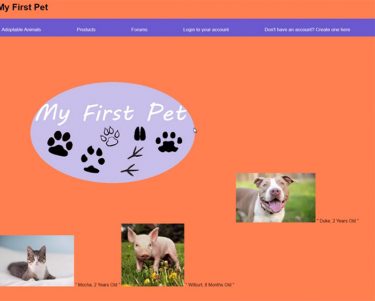
Animal lover Shelby Clow, in deciding on her capstone project with fellow computer science major Kolten Spencer, wanted to create something for first-time pet owners.
“We came up with this project because we’re both passionate about animals. And there’s not really a one-stop shop out there for pet owners. So we wanted to create a place where a user can have all of that in one place,” Clow said.
Move over, Petfinder. Their answer: My First Pet.
The web application for first-time pet owners gives them access to just about everything: One tab spotlights adoptable animals in the area, another features pet products – an apropos feature, considering Clow and Spencer’s computer science degrees tout an emphasis in business entrepreneurship. A third area features a pet forum so first-time pet owners can meet virtually and share ideas.
Computer programming major Taylor Rosby, who’s interning at a medical startup in Chandler, looked to her favorite holiday, Halloween, in creating her project, a 2D iOS platforming game called Halloween Hideout.
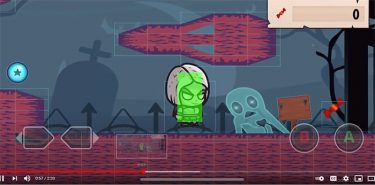
Players choose a character that collects candy, which in turn can be used to buy costumes that give the character special abilities.
“It was a steep learning curve for me and a lot of long nights,” said Rosby, who said she didn’t know much about the technology she had to use to create the game, including the programming language Swift, Core Data and Apple integrated development environment XCode.
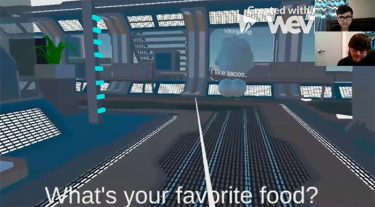
Deep Contractor and Michael Stauffer also dug deep to complete their project, a virtual reality chatroom where people who don’t speak the same language can communicate in a face-to-face environment despite the language barrier.
“How many hours did you spend on this?” asked a visitor to Contractor and Stauffer’s virtual breakout room. “I know VR is not easy to program.”
“I spent more hours in this class than any other class, about seven hours a week every week,” said Contractor, a computer science major with an emphasis in game design and simulation.
“I thought of this idea from this one random film,” Stauffer said of coming up with a multilingual chatroom.
Chatroom users select the virtual room they want to hang out in – a medieval themed room, sci-fi room or office space. Once there, they speak to each other using a set of selected phrases. Those phrases are translated via subtitles to the chosen language of the other person in the room.
Currently, the chatroom accommodates three languages -- English, French and Spanish. Characters can ask things like, “What’s your favorite food?” or “How are you?”
The original idea, said Contractor and Stauffer, was for a user to say anything in the chatroom rather than be limited to common phrases, but they ran into problems and had to pivot.
The accuracy of the translations depends on Google Cloud’s Translation API, the translator that Google uses. “It’s as accurate as Google is,” Contractor said.

Computer programming major Bryce Schmisseur needed no translation in the presentation of his project, iHeartRate, an Apple Watch and web health application. The app sends collected heart rate information from the watch to the website, where users can look at their heart rate dashboard and see their heartbeats per minute at a given date and time and even can see a graph of their heart rate. They also can see their average heart rate and can print out a report log.
Schmisseur came up with the idea for the app after thinking back to his soccer days and what coaches had to do to monitor their players’ heart rates.
“We used to have heart rate monitors we had to wear as a vest,” he said. He thought an Apple Watch app would be more convenient. “This dashboard displays all of a team’s heart rates. It’s just an easier way to look at everyone’s information all at once.”
The big challenge for him, he said, was that he had to learn pretty much everything that went into this app, which he wrote in Swift along with a full reporting application written in React and Express. Some of the technologies he used: Heroku, Docker, Express and MongoDB, to name a few.

“All the technologies were learned this year,” Schmisseur said, but it was worth the effort since the languages he used are being used currently by the top companies in the world. Knowing them makes him more marketable.
Computer programming major Holland Aucoin made herself more marketable by creating a dazzling portfolio that isn’t your grandma’s single-sheet-of-paper resume.
Her My Portfolio app combines contents of her resume, LinkedIn profile and GitHub into a single platform. She thought of the idea, she said, when she applied for summer internships and “caught myself hoping that hiring managers would look at each of those in order to get a full overview of who I am as a person and as a software developer.”
Her website includes five pages: Projects, Experience, Education, About and Contact.
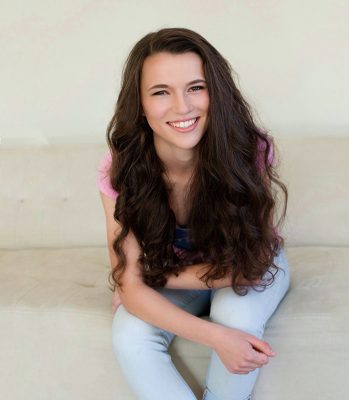
“My computer knowledge before going to college, as far as real technical skills, I didn’t have any,” said Aucoin who, before her portfolio project, didn’t know anything about React, Spring Boot or MongoDB. She wanted to incorporate those new technologies “to challenge myself while completing my final project with widely used technologies.”
And that’s what Reha loves about the senior Technology Capstone Showcase.
“It truly is a culmination of four years of students studying their craft and applying their knowledge to solve a tough problem,” he said. “I continue to be impressed with each and every graduating class from the Technology College at GCU. This year’s class was no different. There are truly some very talented students whose quality of their software designs and ability to solve tough problems using new technologies and architecture styles is simply very impressive."
GCU senior writer Lana Sweeten-Shults can be reached at [email protected] or at 602-639-7901.
***
To view computer science capstones: Click here
***
Related content:
GCU Today: Engineering, tech students showcase their ingenuity
GCU Today: Symposium/Showcase shows range of research















